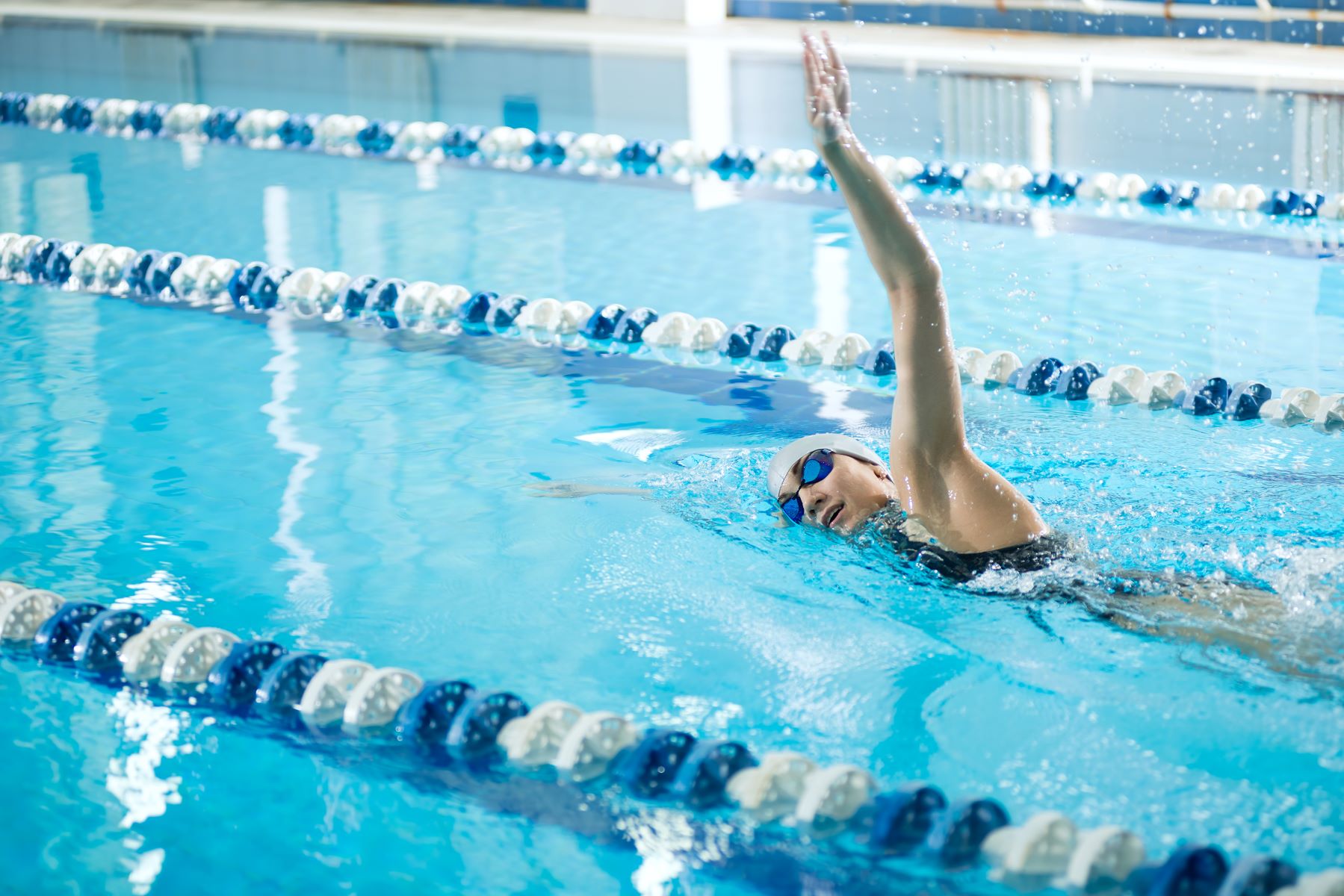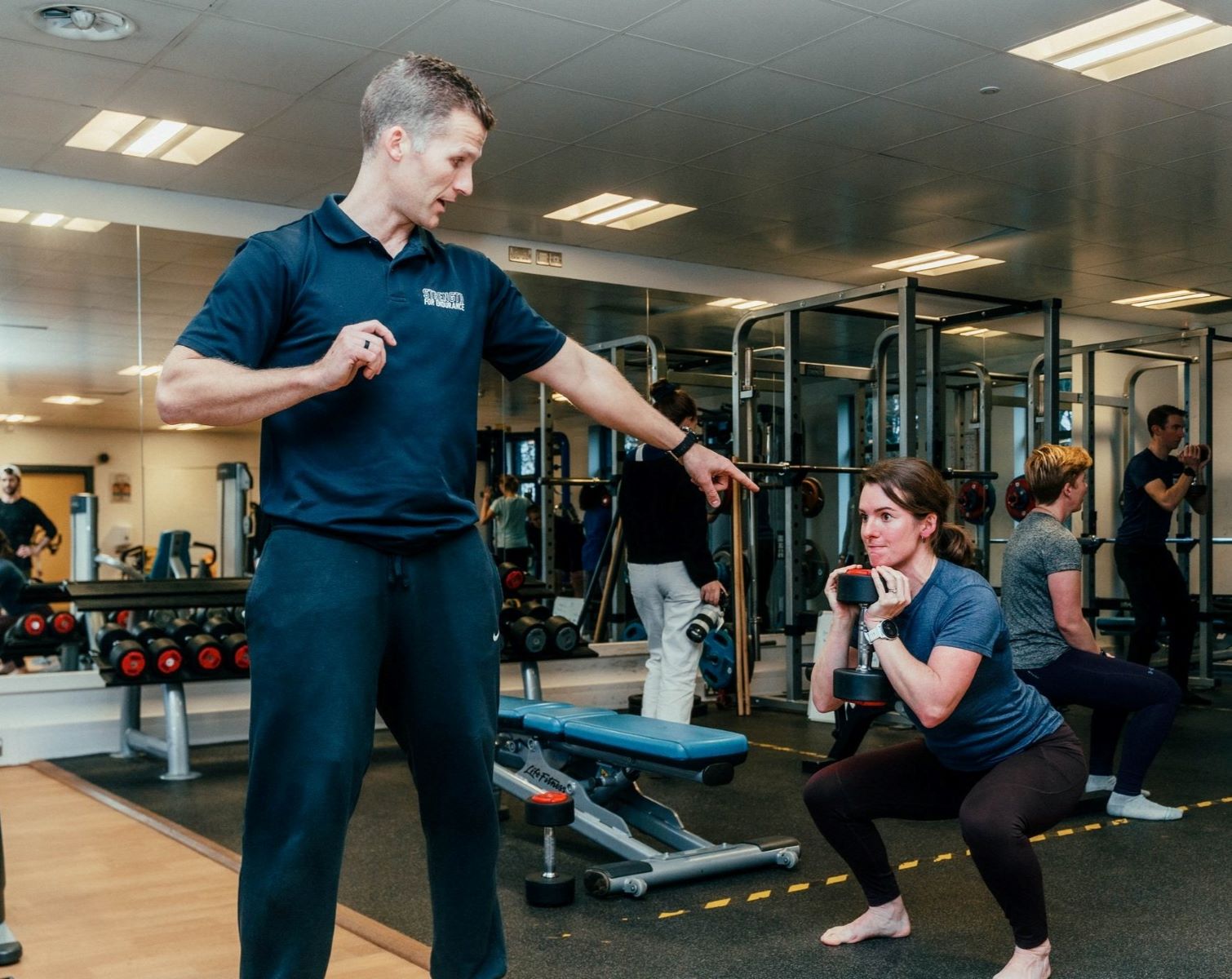Home>Misc>Featured>How Does Swimming Improve Cardiorespiratory Endurance


Featured
How Does Swimming Improve Cardiorespiratory Endurance
Modified: January 22, 2024
Discover the amazing benefits of swimming for improving your cardiorespiratory endurance. Dive into our featured article to learn how swimming can boost your fitness levels.
Introduction
Welcome to the world of swimming, a sport that not only offers numerous physical and mental benefits but also plays a significant role in improving cardiorespiratory endurance. Whether you’re an aspiring athlete, a fitness enthusiast, or simply someone looking to lead a healthier lifestyle, understanding the impact of swimming on cardiorespiratory endurance is essential.
Cardiorespiratory endurance, often referred to as cardiovascular fitness, is the ability of the heart, blood vessels, and lungs to deliver oxygen and nutrients to working muscles during prolonged exercise. It is a crucial component of overall fitness and is associated with a reduced risk of cardiovascular diseases, improved stamina, and enhanced quality of life.
Swimming, a low-impact exercise, offers a unique and effective way to enhance cardiorespiratory endurance. Unlike other forms of aerobic activities, swimming provides a full-body workout that engages multiple muscle groups while minimizing stress on the joints. This makes it an excellent option for individuals of all ages and fitness levels.
In this article, we will explore the benefits of improving cardiorespiratory endurance, delve into the various ways swimming can enhance this aspect of fitness, and provide valuable insights into techniques, workouts, and precautions to help you make the most out of your swimming routine.
Understanding Cardiorespiratory Endurance
Before we dive into the ways swimming can improve cardiorespiratory endurance, let’s first gain a deeper understanding of what this term entails. Cardiorespiratory endurance refers to the ability of the cardiovascular and respiratory systems to efficiently deliver oxygen and nutrients to the working muscles during physical activity. It is a vital component of overall fitness and is closely linked to cardiovascular health.
To comprehend the importance of cardiorespiratory endurance, it is necessary to understand the role of the cardiovascular and respiratory systems. The cardiovascular system consists of the heart, blood vessels, and blood. Its primary function is to transport oxygen, nutrients, hormones, and waste products throughout the body. Meanwhile, the respiratory system, composed of the lungs and airways, helps us breathe in oxygen and expel carbon dioxide, a waste product of cellular metabolism.
During physical exercise, the demand for oxygen and energy increases. In response, the heart pumps more blood, and the lungs work harder to supply oxygen to the working muscles. These adaptations improve the efficiency of the cardiovascular and respiratory systems, leading to enhanced cardiorespiratory endurance.
Having good cardiorespiratory endurance offers numerous benefits for our overall health and well-being. Improved cardiovascular fitness reduces the risk of heart disease, high blood pressure, and other chronic conditions. It also boosts our stamina, allowing us to engage in physical activities for longer durations without feeling fatigued. Additionally, enhanced cardiorespiratory endurance can improve sleep, mental well-being, and cognitive function.
To assess cardiorespiratory endurance, fitness professionals often use tests such as the VO2 max test or the Cooper test. These tests measure the maximum amount of oxygen that the body can utilize during intense exercise and provide an estimate of an individual’s overall aerobic fitness level.
Now that we have a solid understanding of cardiorespiratory endurance and its significance, let’s explore how swimming can be a valuable tool in improving this aspect of fitness.
Benefits of Improving Cardiorespiratory Endurance
Improving cardiorespiratory endurance through regular exercise, such as swimming, offers a multitude of benefits that extend beyond just physical fitness. Let’s take a closer look at some of the advantages:
- Enhanced cardiovascular health: Regular aerobic exercise, which improves cardiorespiratory endurance, strengthens the heart muscle, reduces the risk of heart disease, lowers blood pressure, and improves overall cardiovascular health.
- Increased stamina and endurance: When cardiorespiratory endurance is improved, the body becomes more efficient at delivering oxygen and nutrients to the muscles. This results in increased stamina and endurance, enabling individuals to engage in physical activities for longer periods without feeling exhausted.
- Weight management: Engaging in activities that improve cardiorespiratory endurance helps individuals maintain a healthy weight or lose excess weight. Regular swimming can burn a significant number of calories, contributing to weight loss and weight maintenance.
- Improved respiratory function: Developing cardiorespiratory endurance enhances lung capacity and efficiency, leading to improved respiratory function. This can positively impact breathing patterns, reduce breathlessness during physical activity, and improve overall lung health.
- Increased energy levels: Regular exercise, including swimming, stimulates the release of endorphins, which are known as “feel-good” hormones. This can lead to increased energy levels and improved mood, helping combat feelings of fatigue and boosting overall well-being.
- Reduced risk of chronic diseases: Those with good cardiorespiratory endurance have a lower risk of developing chronic conditions such as obesity, type 2 diabetes, certain types of cancer, and metabolic disorders.
- Mental benefits: Engaging in activities that improve cardiorespiratory endurance has been shown to have positive effects on mental health and cognitive function. Regular exercise can reduce stress, alleviate symptoms of anxiety and depression, and enhance cognitive abilities such as memory and focus.
These benefits emphasize the importance of focusing on improving cardiorespiratory endurance and incorporating activities like swimming into our fitness routines. The next section will explore how swimming specifically contributes to enhancing cardiorespiratory endurance.
Role of Swimming in Enhancing Cardiorespiratory Endurance
Swimming is an excellent activity for improving cardiorespiratory endurance due to its unique combination of cardiovascular and respiratory benefits. Here’s how swimming enhances this aspect of fitness:
- Full-body workout: Swimming engages multiple muscle groups simultaneously, providing a complete workout for the entire body. This includes the arms, legs, core, and back muscles. By constantly moving in the water, the body’s cardiovascular system is stimulated, leading to improved endurance.
- Low-impact exercise: In swimming, the water’s buoyancy reduces the impact on your joints, making it an ideal choice for individuals with joint pain, arthritis, or other conditions that may limit high-impact activities. This allows for longer and more comfortable workouts, promoting better cardiovascular fitness over time.
- Aerobic activity: Swimming is a highly aerobic activity that elevates the heart rate and increases oxygen intake. This aerobic nature of swimming helps strengthen the heart and lungs, improving their efficiency and overall cardiovascular health.
- Interval training possibilities: Swimming offers various interval training opportunities that can effectively enhance cardiorespiratory endurance. Interval training involves alternating between high-intensity and low-intensity periods, challenging the cardiovascular and respiratory systems and improving their capacity to deliver oxygen to the muscles.
- Regulated breathing: Swimming requires controlled and rhythmic breathing techniques, allowing individuals to develop better breath control and utilization of oxygen. This can improve lung capacity and overall respiratory function, enhancing cardiorespiratory endurance.
- Resistance training: Swimming against the resistance of water provides a unique strength-building aspect to cardiovascular exercise. This resistance challenges the muscles, increasing their endurance and leading to improved overall fitness.
- Longer duration workouts: Swimming allows for longer duration workouts compared to other high-impact activities due to its low-impact nature. This extended exercise session contributes to improved cardiorespiratory endurance as it requires the heart and lungs to work at a sustained rate over an extended period.
By incorporating swimming into your fitness routine, you can significantly enhance your cardiorespiratory endurance. The next sections will explore the specific cardiovascular, respiratory, and muscular benefits of swimming in more detail.
Cardiovascular Benefits of Swimming
Swimming is a highly effective cardiovascular exercise that offers numerous benefits for heart health and overall cardiovascular fitness. Here are some of the specific cardiovascular benefits of swimming:
- Improved heart strength: Swimming regularly helps strengthen the heart muscle. As you swim, your heart has to work harder to pump blood throughout your body, leading to increased heart strength and efficiency.
- Increased circulation: The repetitive movements and resistance of the water during swimming promote better blood flow. This improved circulation allows for better delivery of oxygen and nutrients to the muscles and organs, enhancing overall cardiovascular health.
- Lower resting heart rate: Regular swimming can lead to a lower resting heart rate. A lower resting heart rate signifies that the heart is functioning more efficiently, requiring fewer beats per minute to pump blood throughout the body. This is a sign of good cardiovascular health.
- Reduced blood pressure: Swimming helps lower blood pressure by improving blood vessel elasticity and reducing resistance to blood flow. Engaging in regular swimming can contribute to managing and reducing high blood pressure, reducing the risk of heart disease and stroke.
- Enhanced aerobic capacity: Swimming is an excellent aerobic exercise that increases the body’s oxygen demand. As your cardiovascular system adapts to meet this demand, your aerobic capacity improves, allowing you to engage in physical activities with less effort and fatigue.
- Weight management: Swimming is an effective calorie-burning exercise that can aid in weight management. Maintaining a healthy weight is crucial for cardiovascular health, as excess weight can contribute to conditions such as high blood pressure and heart disease.
- Reduced LDL cholesterol levels: Regular swimming has been shown to help lower LDL cholesterol levels, also known as “bad” cholesterol. High levels of LDL cholesterol can increase the risk of plaque buildup in the arteries, leading to heart disease. Swimming can help improve cholesterol ratios and promote a healthier cardiovascular profile.
Swimming offers a wide range of cardiovascular benefits, making it an excellent exercise for improving heart health and overall cardiovascular fitness. The next section will delve into the respiratory benefits of swimming and its impact on enhancing cardiorespiratory endurance.
Respiratory Benefits of Swimming
In addition to its cardiovascular advantages, swimming also provides several respiratory benefits that contribute to the enhancement of overall cardiorespiratory endurance. Here are some of the specific respiratory benefits of swimming:
- Improved lung capacity: Swimming requires rhythmic breathing patterns and controlled exhalation while underwater. This practice helps expand lung capacity and improve respiratory function over time. With regular swimming, your lungs become more efficient at taking in oxygen and expelling carbon dioxide.
- Enhanced respiratory muscle strength: Swimming engages the muscles involved in respiration, such as the diaphragm, intercostal muscles, and accessory respiratory muscles. The resistance of water provides a challenging workout for these muscles, leading to increased strength and endurance.
- Decreased breathlessness: Engaging in aerobic activities like swimming can reduce feelings of breathlessness during physical exertion. The improved lung capacity, better breathing control, and increased efficiency of the respiratory muscles contribute to a decreased sensation of breathlessness, allowing individuals to engage in physical activities with greater ease.
- Reduced risk of respiratory conditions: Swimming has been shown to have a positive impact on respiratory health and reduce the risk of developing respiratory conditions such as asthma. The controlled breathing technique employed during swimming can help individuals manage and control their breathing, alleviating symptoms associated with respiratory conditions.
- Enhanced oxygen utilization: Swimming promotes efficient oxygen utilization within the body. With improved lung capacity and respiratory muscle strength, swimmers can take in more oxygen per breath and deliver it efficiently to the working muscles. This optimization of oxygen uptake and utilization contributes to improved overall cardiorespiratory endurance.
- Better breathing control: Swimming encourages individuals to develop better breath control through regulated breathing techniques. Whether it’s bilateral breathing or rhythmic exhalation, these techniques enhance the ability to control the breath, allowing swimmers to maintain longer and more sustained movements in the water.
- Enhanced pulmonary function: Swimming can positively impact pulmonary function by increasing lung ventilation and improving the exchange of oxygen and carbon dioxide. Regular swimming sessions stimulate the respiratory system, leading to improved lung function and respiratory efficiency.
These respiratory benefits highlight the crucial role of swimming in improving cardiorespiratory endurance. By incorporating swimming into your fitness routine, you can reap these advantages and enhance your overall respiratory health and endurance. The next section will explore the muscular benefits of swimming and its impact on enhancing cardiorespiratory endurance.
Muscular Benefits of Swimming
Swimming offers a multitude of muscular benefits that contribute to the improvement of overall cardiorespiratory endurance. Let’s explore some of the key muscular benefits of swimming:
- Full-body workout: Swimming engages multiple muscle groups simultaneously, providing a comprehensive workout for the entire body. The arms, shoulders, chest, back, core, and leg muscles all work together to propel you through the water, resulting in improved muscular strength and endurance.
- Increased muscular strength: As you swim against the resistance of the water, your muscles continuously work to overcome this resistance. Over time, this leads to increased muscular strength, particularly in the upper body, core, and leg muscles, which are heavily involved in swimming movements.
- Improved muscle tone and definition: Regular swimming helps tone and define the muscles of the body. The resistance provided by the water encourages muscle development, resulting in a lean and toned physique. Swimming can contribute to improved muscle definition in the arms, shoulders, back, and core muscles.
- Enhanced muscular endurance: Swimming requires sustained effort and repetition of movements, which can significantly improve muscular endurance. By consistently challenging and training the muscles during swimming sessions, you can increase their capacity to perform for longer durations without fatigue.
- Low-impact on joints: Unlike high-impact exercises such as running or jumping, swimming is a low-impact activity that reduces stress on the joints. This makes it an ideal choice for individuals with joint pain or conditions such as arthritis, allowing them to engage in a full-body workout without exacerbating joint discomfort.
- Balanced muscle development: Swimming promotes balanced muscle development throughout the body. The symmetrical movements required in swimming help create balanced strength and coordination between the left and right sides of the body, preventing muscle imbalances that can lead to injuries and postural issues.
- Increased flexibility: The range of motion required for swimming movements contributes to increased flexibility. Stretching and elongating the muscles in the water help improve joint flexibility and overall muscle elasticity, which can enhance athletic performance and reduce the risk of injuries.
By engaging in regular swimming, you can enjoy these muscular benefits, leading to improved overall strength, endurance, and tone. The next section will discuss techniques to improve cardiorespiratory endurance in swimming, providing you with practical strategies to maximize your workouts.
Techniques to Improve Cardiorespiratory Endurance in Swimming
Swimming is an effective exercise for improving cardiorespiratory endurance, but employing specific techniques can further enhance your workouts. Here are some techniques to improve cardiorespiratory endurance in swimming:
- Interval training: Incorporate interval training into your swimming routine to challenge your cardiovascular and respiratory systems. Alternate between high-intensity and low-intensity sets, such as sprinting for a lap and then swimming at a steady pace for two laps. This variation helps improve endurance and overall cardiovascular fitness.
- Increase distance and duration: Gradually increase the distance and duration of your swimming sessions to build endurance. Start by swimming for a set time or distance and gradually add more laps or increase the duration as your cardiorespiratory endurance improves.
- Focus on breathing technique: Proper breathing technique is essential for optimizing cardiorespiratory endurance in swimming. Practice rhythmic breathing, such as breathing every three strokes or using bilateral breathing (alternating sides). Efficient breathing ensures a steady supply of oxygen to your muscles, enhancing endurance.
- Incorporate different strokes: Swim using different strokes, such as freestyle, backstroke, butterfly, and breaststroke, to target different muscle groups and challenge your cardiorespiratory system in various ways. This variation helps improve overall endurance and prevents monotony in your workouts.
- Progressive overload: Gradually increase the intensity or volume of your swimming workouts over time. Aim to swim faster or farther, add more challenging drills, or increase the resistance by using training equipment like fins or paddles. Progressive overload stimulates adaptations in your cardiovascular and respiratory systems, leading to improved endurance.
- Include interval sets: Experiment with interval sets in your swimming routine. For example, swim at a faster pace for a set distance and then recover by swimming at a slower pace for a specific duration. This type of training challenges your heart and lungs, improving their capacity to handle intense exercise.
- Cross-training: Incorporate other forms of cardiorespiratory exercise into your routine to complement your swimming workouts. Activities like running, cycling, or rowing can provide additional cardiovascular benefits and help improve overall endurance.
- Consistency: Consistency is key in improving cardiorespiratory endurance. Aim for regular swimming sessions, ideally three to five times per week, to gradually build endurance over time. Even shorter, more frequent workouts can be effective in improving fitness levels.
By implementing these techniques and being consistent with your swimming routine, you can maximize your cardiorespiratory endurance improvements and enjoy the many benefits that come with enhanced fitness levels.
Sample Swimming Workout for Cardiovascular Fitness
Below is a sample swimming workout designed to improve cardiovascular fitness and enhance cardiorespiratory endurance. This workout incorporates interval training and progressive overload principles:
- Warm-up: Begin with a 5-10 minute warm-up, swimming at a comfortable pace. Focus on proper breathing and gradually increase your effort level.
- Interval Sets: Perform the following interval sets to challenge your cardiovascular system and improve cardiovascular fitness:
- Set 1: Swim 4 laps (100 meters) at a moderately challenging pace, followed by a slow-paced recovery lap. Repeat this set four times.
- Set 2: Swim 2 laps (50 meters) at a fast pace, followed by a slow-paced recovery lap. Repeat this set four times.
- Set 3: Swim 1 lap (25 meters) at maximum effort, followed by a slow recovery lap. Repeat this set four times.
- Drills: Include drills between interval sets to focus on technique and engage different muscle groups:
- Kickboard Drill: Hold a kickboard in front of you and kick solely with your legs, focusing on a steady and powerful kick. Perform 4 laps.
- Pull Buoy Drill: Place a pull buoy between your legs and focus on using only your arms to propel yourself through the water. Perform 4 laps.
- Cool-down: Finish the workout with a 5-10 minute cool-down, swimming at an easy and relaxed pace. Slowly decrease your effort level and focus on controlled breathing.
Remember to adjust the distances and intensity of the sets based on your current fitness level. As you progress, gradually increase the number of sets, distance, or intensity to continue challenging your cardiovascular fitness.
It is important to note that this is just a sample workout. Feel free to customize and modify it based on your preferences and abilities. Working with a swimming coach or fitness professional can provide valuable guidance and help you tailor your workouts to meet your specific goals.
By consistently incorporating this type of workout into your swimming routine, you can effectively improve your cardiovascular fitness and enhance your overall cardiorespiratory endurance.
Precautions and Considerations for Swimming as a Cardiovascular Exercise
While swimming is a fantastic cardiovascular exercise that offers numerous benefits, it’s important to take certain precautions and considerations to ensure a safe and effective workout. Here are some key points to keep in mind:
- Start gradually: If you’re new to swimming or haven’t swum in a while, start gradually and gradually increase the duration and intensity of your workouts. Allow your body time to adapt to the demands of swimming and avoid overexertion.
- Proper form and technique: Focus on maintaining proper form and technique during swimming to prevent unnecessary strain or injury. Consider taking lessons or working with a certified swimming instructor to learn and refine your swimming technique.
- Breathe properly: Breathing is vital during swimming, so practice proper breathing technique to avoid breathlessness or discomfort. Regular and rhythmic breathing, such as bilateral breathing or breathing every third stroke, can help maintain a consistent oxygen supply.
- Stay hydrated: Even though you’re surrounded by water, swimming is still a physically demanding activity that can cause dehydration. Stay hydrated before and after your swimming session, and take regular sips of water during breaks if needed.
- Warm-up and cool-down: Prioritize a proper warm-up and cool-down before and after swimming. This helps prepare your body for the workout and aids in recovery, reducing the risk of muscle soreness or injury.
- Listen to your body: Pay attention to your body’s signals and adjust your swimming intensity or duration accordingly. If you experience pain, dizziness, or excessive fatigue, take a break and consult a healthcare professional if symptoms persist.
- Pool safety: If you’re swimming in a pool, be mindful of pool safety. Follow any specific rules and regulations of the pool facility, ensure proper supervision for individuals who may need it, and be aware of others sharing the pool space.
- Consider swimming conditions: If you’re swimming in open water, be mindful of the weather conditions, water temperature, and currents. Take necessary safety precautions, such as wearing a wetsuit or using a buoy for visibility, and always swim in designated areas with proper supervision if required.
- Consult a healthcare professional: If you have any underlying health conditions or concerns, it’s advisable to consult with a healthcare professional before starting a swimming or exercise program to ensure it is safe and appropriate for you.
By taking these precautions and considerations into account, you can minimize the risk of injury, optimize your swimming workouts, and enjoy the full benefits that swimming offers for improving cardiorespiratory endurance.
Conclusion
Swimming is an exceptional form of exercise that offers a multitude of benefits for improving cardiorespiratory endurance. By engaging in regular swimming workouts and implementing appropriate training techniques, you can enhance your cardiovascular and respiratory systems, improve muscle strength and endurance, and boost overall fitness levels.
Through its full-body engagement, low-impact nature, and versatility, swimming provides a unique and effective way to enhance cardiorespiratory endurance. The cardiovascular benefits of swimming include improved heart strength, increased circulation, and reduced blood pressure. Meanwhile, the respiratory benefits involve enhanced lung capacity, increased breathing control, and improved oxygen utilization.
Furthermore, swimming offers significant muscular benefits, including improved strength, tone, and endurance. The low-impact nature of swimming makes it accessible to individuals of all fitness levels and ages, while the ability to vary strokes and incorporate interval training allows for tailored workouts to meet specific goals. By following proper techniques, gradually increasing intensity, and incorporating drills and interval sets, you can optimize your swimming workouts for maximum cardiovascular fitness and endurance improvement.
As with any exercise, it is essential to take precautions and considerations when swimming. Start gradually, maintain proper form and technique, stay hydrated, warm up and cool down, and listen to your body to prevent injury and ensure a safe and effective workout. Additionally, considering pool safety and open water conditions adds an extra layer of precaution.
In conclusion, swimming is a rewarding and enjoyable activity that not only improves cardiorespiratory endurance but also enhances overall health and well-being. So grab your swimsuit, dive into the pool or open water, and experience the incredible benefits that swimming has to offer for your cardiorespiratory fitness.









